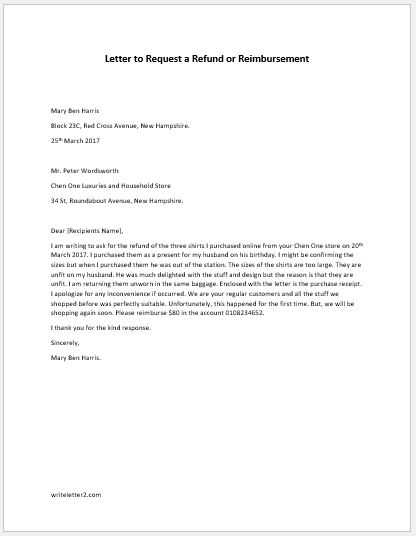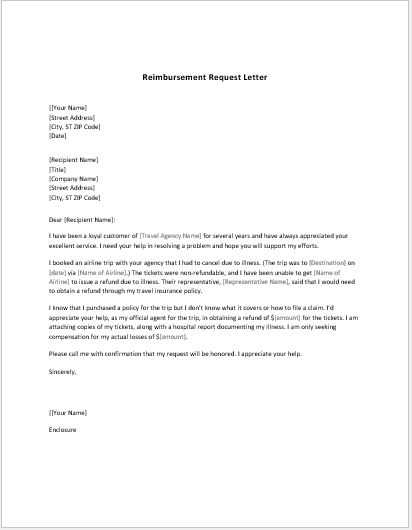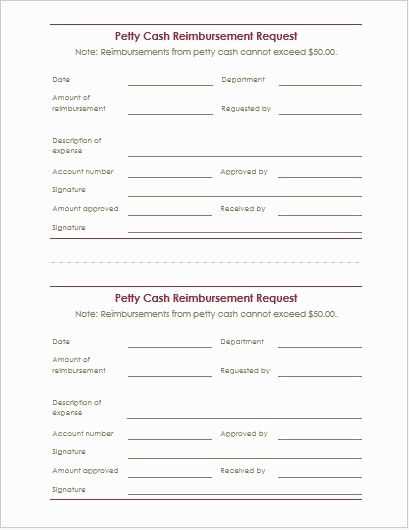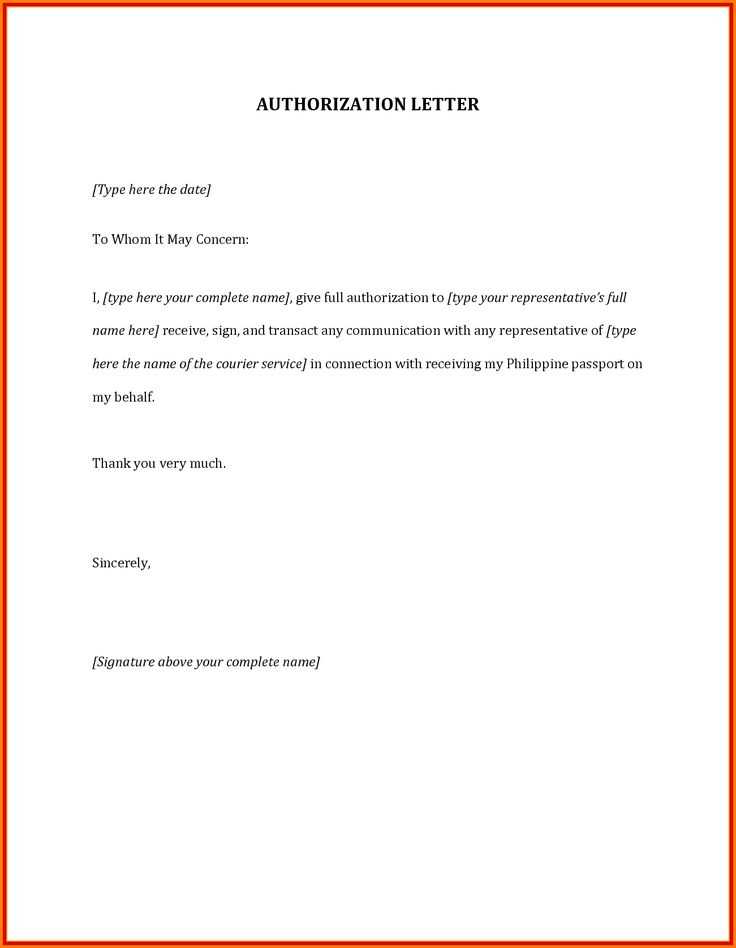Request for Reimbursement Letter Template

When seeking a refund or repayment from a company, organization, or employer, presenting your case in writing is often essential. A well-crafted document can ensure clarity and professionalism, increasing your chances of a successful outcome. Knowing how to structure this communication can help you make your request efficiently and effectively.
There are several key points to consider when drafting such a document. The tone should be polite yet assertive, providing the necessary details without being overly complex. It’s crucial to include relevant information such as the amount owed, the reason for the claim, and any supporting documentation that can strengthen your case. Crafting a precise and clear message can also demonstrate your attention to detail and organizational skills.
By following a straightforward approach, you can ensure that your compensation claim is addressed promptly. The right structure and content can significantly impact the process, helping you achieve the desired resolution quickly and smoothly.
Understanding the Reimbursement Request Process
Submitting a formal claim for a financial return involves several key steps that need to be followed carefully. Understanding the process is crucial to ensure that the claim is handled efficiently and in a timely manner. This process typically requires clear communication, supporting documents, and a well-organized submission to increase the chances of a successful resolution.
Initial Preparation and Documentation

Before taking any action, it’s essential to gather all necessary evidence related to the claim. This may include receipts, invoices, or other documents that verify the transaction or expenditure. A clear description of the situation and the reason for the claim should also be outlined. Being prepared with all required documents helps avoid delays and confusion later on.
Submission and Follow-up
Once the documentation is ready, the next step is submitting the request to the appropriate party. Whether it’s an employer, insurance company, or vendor, make sure the submission is addressed correctly and through the proper channels. Afterward, following up to ensure your claim is being processed can help maintain momentum and encourage timely action.
Key Elements of a Reimbursement Letter
When crafting a formal claim for financial return, certain components are essential to ensure that the communication is clear, professional, and persuasive. These elements help the recipient understand the context and reasoning behind the claim, making it easier for them to process and approve the request.
Details of the Claim – It’s crucial to include a detailed description of the transaction or expense in question. This should include dates, amounts, and any relevant context that justifies the claim. Providing clear and specific information prevents confusion and strengthens the case for approval.
Supporting Documents – Including necessary evidence, such as receipts, invoices, or proof of payment, is an essential part of the process. These documents verify the validity of the claim and give the recipient the assurance they need to process the request promptly.
Clear and Polite Language – The tone should be respectful yet firm. Using professional language demonstrates seriousness and fosters a positive relationship with the recipient. Make sure to express gratitude and appreciation for their time and consideration, as this can create a favorable impression.
Step-by-Step Guide to Writing Your Letter
Creating an effective document for claiming a financial return requires careful planning and attention to detail. By following a clear structure and including all necessary information, you can ensure that your submission is both complete and compelling. Below is a simple guide to help you craft your document effectively.
- Begin with the Date and Recipient’s Information – Start by including the date at the top, followed by the recipient’s name, title, and contact details. Address the person or department that will handle your submission.
- State the Purpose of the Communication – Clearly mention the reason for reaching out. Specify the nature of the claim and the amount being requested.
- Provide Detailed Information – List relevant details such as the transaction date, total amount, and any supporting evidence. Be as specific as possible to avoid confusion.
- Include Supporting Documents – Attach or reference any receipts, invoices, or proof of payment that validate the claim. Make sure they are easy to understand and clearly labeled.
- Conclude Politely – End the communication with a courteous note, thanking the recipient for their time and attention. Request confirmation of receipt or an update on the process.
By following these steps, you can create a well-organized document that enhances your chances of a successful outcome.
Common Mistakes to Avoid in Reimbursement Requests
When seeking compensation for out-of-pocket expenses, it is essential to follow proper guidelines to ensure approval. Failing to adhere to best practices can lead to delays, rejections, or unnecessary complications. Understanding common pitfalls and how to avoid them will streamline the process and increase the likelihood of a successful outcome.
One frequent error is not providing adequate documentation. Without clear, itemized receipts or proof of purchase, it becomes difficult to verify the validity of the claim. Always ensure that all supporting evidence is well-organized and legible.
Another mistake is submitting incomplete forms or missing information. Failing to fill out all required fields or leaving out crucial details can cause confusion and result in unnecessary follow-ups. Double-check all entries before submitting.
Additionally, ignoring deadlines can seriously hinder the approval process. Always verify the time frames within which claims must be submitted and ensure that they are submitted on time. Late submissions can be rejected outright.
Finally, not adhering to the specific guidelines set forth by the company or organization can lead to complications. Every entity has its own set of requirements, and overlooking these can prevent the claim from being processed correctly. Review all instructions carefully before proceeding.
How to Tailor Your Request for Different Situations
Adapting your communication based on the circumstances is crucial when seeking compensation. Each scenario may require a different approach to increase the chances of a successful outcome. Recognizing the unique aspects of each situation and adjusting your message accordingly will help ensure clarity and relevance in your submission.
Consider the Relationship with the Recipient

The tone and level of detail should vary depending on whether you are addressing a colleague, supervisor, or external organization. A more formal approach may be required when dealing with a third party, while a more casual tone can be used for internal claims. Understanding the relationship will guide how to present your case.
Highlight Relevant Information Based on the Situation

In some cases, the focus may be on urgency, while in others, the emphasis might be on the accuracy of the supporting documents. Recognizing which elements are most important to your audience will allow you to tailor your message effectively. Always prioritize the information that aligns with the recipient’s expectations and the purpose of the claim.
| Scenario | Focus | Tone |
|---|---|---|
| Internal Claim | Clear documentation, quick approval | Professional but friendly |
| Third-Party Organization | Comprehensive supporting evidence | Formal, polite |
| Urgent Request | Highlight time sensitivity | Direct, respectful |
Tips for Following Up on Your Letter
After submitting a formal communication, it’s important to stay proactive and check on the status of your claim. Following up helps ensure that your submission is being processed and provides an opportunity to address any potential issues or delays. Here are some effective strategies to follow up on your communication.
Be timely. Waiting too long before following up can give the impression that you are not concerned about the matter. Typically, a follow-up should be sent within a week or two, depending on the urgency of the situation. This shows that you are actively monitoring the process without being overly impatient.
Keep your tone polite. It’s crucial to maintain a respectful and professional attitude in your follow-up. Whether you are sending an email or making a phone call, being courteous increases the likelihood of receiving a positive response. Friendly yet firm communication can make a difference in how your claim is handled.
Reference previous communication. When following up, always mention the initial submission and any relevant details to help the recipient locate your information quickly. This can include the date of your original submission, reference numbers, or specific details related to your request. Clear references make it easier for the recipient to respond efficiently.